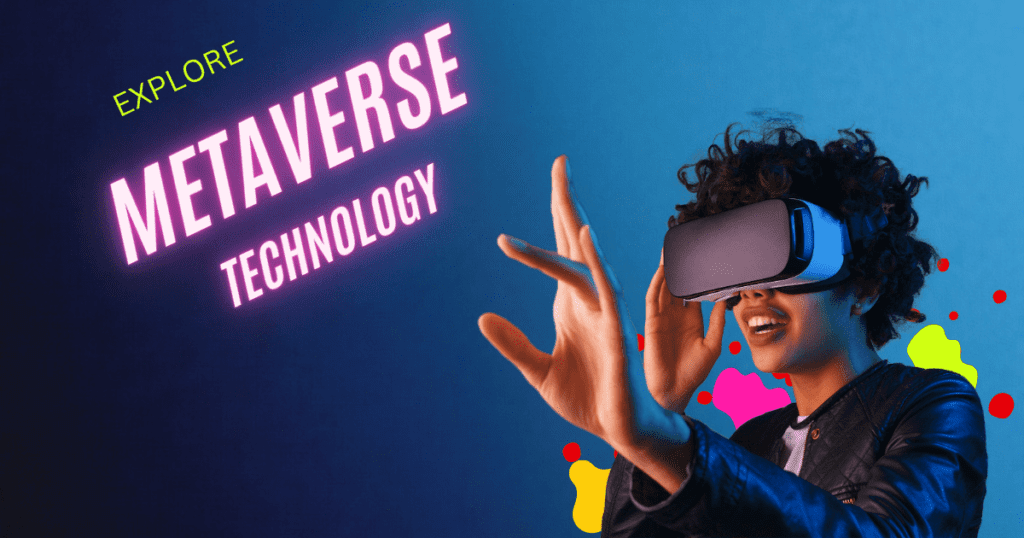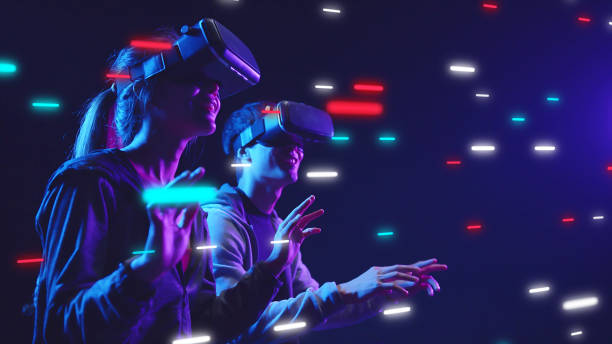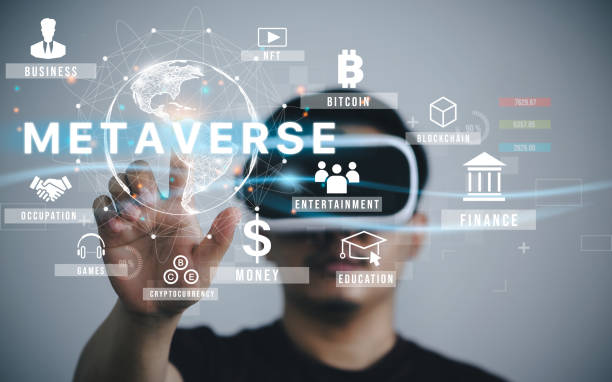This article provides complete information about Metaverse Technology. Metaverse is a term used to describe a virtual and shared space where people can interact with each other and digital objects in an almost real way. It is a collective virtual space created by the convergence of the physical and digital worlds, where users can engage in various activities such as socializing, educating, gaming, learning, and trading. It is not an exaggeration if I say that the future is in the hands of Metaverse Technology and The Future is Here.

What is Metaverse Technology?
The term “Metaverse” was coined by American science fiction writer Neal Town Stephenson in his novel, “Snow Crash” In 1992. In recent years, the term Metaverse has been used to describe various virtual worlds, such as Second Life, Fortnite, and Minecraft, as well as emerging technologies like virtual and augmented reality. Companies like Facebook, Google, and Microsoft are investing heavily in creating their own metaverse platforms.
The idea behind Metaverse Technology is to create a fully interactive and social experience that is beyond any possibilities in the physical world. It is envisioned as a platform for people involved in entertainment, education, work, and socializing.

Top 5 Application Areas of Metaverse
The Metaverse has the potential to transform the way we interact with each other and the world, creating new opportunities for collaboration, innovation, and entertainment. The applications of Metaverse are vast and varied as it could change the way we interact with each other, do business, and experience the world around us.

Healthcare
The healthcare sector is one of the areas where Metaverse Technology has significant potential applications, particularly with the use of Augmented Reality (AR). AR has become a crucial tool in improving the skills and knowledge of medical students. In addition to providing pre-operative images from MRI, CT, and 3D scans, AR headsets can facilitate the viewing of real-time patient data. This technology can aid in the monitoring of vital patient data, such as body temperature, respiration rate, heart rate, and blood pressure, making patient care more manageable. Additionally, visual-based technologies like CT scans and X-rays are also suitable for transition into the metaverse healthcare space.
Real Estate
The real estate industry is another promising area for the application of Metaverse Technology. Virtual Reality (VR) is a significant technology that can provide immersive experiences to clients, making it a perfect fit for metaverse applications in real estate. With VR, real estate agents can offer virtual tours of properties to potential buyers, providing them with a realistic and immersive experience. Ambient music, lighting, and sound effects can be included in VR real estate tours, providing clients with an almost real-time experience of the properties. Additionally, agents can use metaverse examples to tailor custom tours according to clients’ preferences, providing a personalized experience.
Education
Metaverse technologies have great potential in the education sector as they provide promising tools for transforming traditional teaching approaches. Virtual Reality (VR) is a powerful tool that can help students learn concepts through visuals, creating engaging and immersive learning environments in various educational institutions. The use of metaverse applications in education can significantly enhance the learning experience for students by overcoming language barriers. The technology can incorporate any language into a metaverse platform, making it accessible to a wider range of students.
Military
The military sector is another area where Metaverse Technology is gaining popularity. Tactical Augmented Reality (TAR) is an important example of metaverse technology used in the military. It provides soldiers with enhanced capabilities by displaying their precise location, as well as the positions of allies and hostiles, similar to night-vision goggles. TAR is an ideal substitute for handheld GPS gadgets and headsets.
Another metaverse application in the military sector is the Synthetic Training Environment. It is an AR system designed to offer soldiers a realistic training experience for soldiers.
Manufacturing
The manufacturing sector is another area where Metaverse Technology has the potential for various applications. Virtual Reality (VR) is one of the top metaverse technologies that can help in training employees on safety precautions and simulate risk scenarios to reduce the risks of accidents at factories and other manufacturing sites. Metaverse applications can also contribute to the development of better products in the long run.
For instance, VR headsets can help manufacturers examine all elements of a product in detail. Additionally, metaverse applications can aid in landscape planning for manufacturing plants and better positioning of equipment.
5 Key Technologies Powering Metaverse Technology
The metaverse is a complex and evolving concept, and the tools and platforms for creating metaverse experiences are still in their early stages. However, there are several tools and technologies that aid in the development of the metaverse. Here are some examples:
Virtual and Augmented Reality (AR and VR)
Virtual and augmented reality technologies are essential components of the metaverse, as they enable users to immerse themselves in virtual environments and interact with digital objects in a more natural and intuitive way. Platforms such as Oculus Quest and HTC Vive provide high-quality VR experiences, while AR platforms such as ARKit and ARCore are used for creating AR experiences.
Game Engines
Creating interactive 3D environments and games is a fundamental aspect of the metaverse experience, and game engines like Unity and Unreal Engine are frequently used for this purpose. These engines offer a variety of tools for developing 3D models, animations, physics simulations, and more.
Blockchain and Cryptocurrency
Blockchain technology and cryptocurrencies play an important role in enabling transactions and secure ownership of virtual assets within the metaverse. Blockchain-based platforms like Decentraland and Somnium Space allow users to buy, sell, and trade virtual land and assets using cryptocurrencies like Bitcoin and Ethereum. This creates a decentralized marketplace for virtual assets, where ownership and transactions are transparent and secure. Blockchain technology also provides a way to authenticate and verify the ownership of virtual assets. This is important in a virtual world where scarcity and ownership are key factors in driving value and creating a sense of ownership and community.
Read More: 👉Blockchain Technology
5G Technology
The development of 5G technology enhances the capabilities and performance of the metaverse. The high data transfer rates and low latency of 5G networks enable seamless and smooth interactions between users and virtual environments, improving the overall user experience. In addition, 5G can support the transfer of large amounts of data, such as high-quality video and 3D models, which are essential for creating immersive virtual environments. 5G networks can also enable real-time communication and collaboration between users, regardless of their location. This can facilitate the creation of virtual teams and enhance remote work and learning experiences.
AI and Machine Learning
Artificial Intelligence (AI) and Machine Learning (ML) technologies are critical components of the metaverse, as they offer numerous benefits. One of the most important applications of AI is enabling intelligent decision-making in virtual environments. With AI and ML, the metaverse can generate unique and dynamic content based on user input, creating more personalized and engaging experiences. AI and ML can also help optimize resource management, reducing the computing power required to create and run virtual environments. This means that metaverse applications can run more efficiently, lowering costs and enabling better scalability.
Moreover, AI and ML can enable natural language processing (NLP) and computer vision capabilities in metaverse applications, allowing users to interact with virtual environments in more natural and intuitive ways. For example, AI-powered chatbots can help users navigate virtual environments and answer questions.
These are just a few examples of the many tools and technologies that are being used or developed for the metaverse. As the concept of the metaverse evolves and new technologies emerge, we will see many more tools and platforms designed specifically for creating and experiencing metaverse environments.
Read More: 👉The Potential of Intelligent Machines
Metaverse Examples
Here are some examples of metaverse applications that have gained popularity in recent times:
- Second Life – It is a 3D virtual world that allows users to create avatars, build virtual objects, and interact with others in a simulated environment.
- Fortnite – It is a massively popular online game consisting of a lot many metaverse elements such as virtual concerts, movie screenings, and in-game purchases.
- Decentraland – It is a blockchain-based virtual world where users can create, experience, and monetize their content. users can buy and sell land, estates, avatar wearables, and names in the Decentraland Marketplace.
- VRChat – It is a social VR platform that allows users to create and share virtual spaces and interact with others through customizable avatars.
- Minecraft – It is a game that allows users to build and explore virtual worlds, with a metaverse-like community and economy.
These metaverse examples showcase the wide range of possibilities that metaverse technologies can offer, from gaming and socialization to content creation and monetization.
Read More: 👉 Metaverse
The future of Metaverse
As the technologies powering the metaverse continue to evolve, the future of the Metaverse Technology is likely to be shaped by them, along with changes in user behavior and preferences. Some experts believe that the metaverse has the potential to become a dominant form of social interaction, commerce, and entertainment as it widens the experience of the physical world. However, there are also concerns about issues such as digital identity, data privacy, and the potential for the metaverse to exacerbate social inequalities.
Conclusion
Finally, it can be said that the metaverse could transform industries such as education, healthcare, and real estate, creating new opportunities for collaboration, learning, and innovation. The future of the metaverse will be influenced by a variety of technological, economic, and social factors, and its evolution and adoption in the coming years are uncertain.
allegheny county real estate Good post! We will be linking to this particularly great post on our site. Keep up the great writing
Wonderful beat I wish to apprentice while you amend your web site how could i subscribe for a blog web site The account aided me a acceptable deal I had been a little bit acquainted of this your broadcast provided bright clear idea
We stumbled over here different web page and thought I
should check things out. I like what I see so now
i am following you. Look forward to exploring your web page for a second time.
Hi to all, because I am in fact eager of reading this website’s post to be updated regularly.
It carries nice data.
BYU Cougars There is definately a lot to find out about this subject. I like all the points you made
My brother suggested I might like this website He was totally right This post actually made my day You cannt imagine just how much time I had spent for this information Thanks
Blue Techker I do not even understand how I ended up here, but I assumed this publish used to be great
Have you ever considered writing an e-book or guest authoring on other
blogs? I have a blog based on the same information you discuss
and would really like to have you share some stories/information. I know my audience
would value your work. If you’re even remotely interested, feel free
to shoot me an e mail.
Thinker Pedia Nice post. I learn something totally new and challenging on websites
Isla Moon This is my first time pay a quick visit at here and i am really happy to read everthing at one place
Noodlemagazine Great information shared.. really enjoyed reading this post thank you author for sharing this post .. appreciated
Noodlemagazine I truly appreciate posts that inspire thoughtful consideration. Also, thank you for letting me share my comment!
Thanks for sharing. I read many of your blog posts, cool, your blog is very good.
hentairead I do not even understand how I ended up here, but I assumed this publish used to be great
Your article helped me a lot, is there any more related content? Thanks! https://accounts.binance.info/en/register?ref=JHQQKNKN